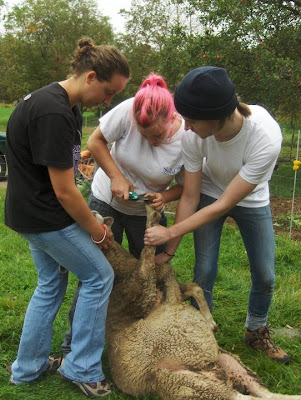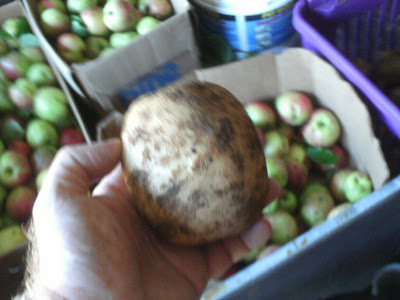


Saturday was the first of two field trips each academic year in which Aimee and I host first year students from Unity College's Captive Wildlife Care and Education program at our farm.
This program, called "Captive" for short among students, trains applied biologists for careers in zoo=keeping and other animal care work at a professional or managerial level. Students may also go into veterinary careers.
It's a very popular program with young women, but there are a handful of young men too. The students are characterized by a particular fondness for animals.
Aimee and I enjoy having the students to the farm because a) it takes away some of the very back-breaking work of sheep care, and b) it's fun to watch the students literally come to grips with the sheep. The professors who run the program, Sarah Cunningham and Cheryl Frederick, are routinely delighted with the arrangement too, because of the great experience for their students at a crucial time in their education.
It's a good trade for all concerned, but especially the students, who like all students need to learn some important lessons.
Sheep are cute and fuzzy, especially our little lambs, but they're also wild and woolly, and will struggle mightily to get out of the shepherds hands.
They also smell.
A lot.
They smell a lot. And it's not a good smell.
I'm not sure how many "Captive" students question their career choices when, often for the first time in their lives, they are told to grab on to their damp, stinky, heavy, powerful, struggling animal and make her assume the proper control position for hoof care or medicine, or whatever peculiar and seemingly perverted task is called for, but if they do, well, that's a good lesson, isn't it?
One that had better be learned sooner rather than later in the college career. If you don't like handling sheep at this point in your career, you aren't going to like giraffe or hippopotami or grizzlum bear very much later, either, and so it may be time to go off and get yourself a communications degree, or join some other less contact-oriented line of work.
Today's task was FAMACHA® care, as well as the ubiquitous dung tags or "dags" for short, and a little hoof trimming. Nothing too difficult, but, as always, animals need to be immobilized and properly handled to manage all this, and it's probably the handling part that is the main lesson.
It's certainly the main emotional lesson. As we routinely tell the students, sheep care is a bit like rugby, and indeed it's no surprise that the regions of the world that produce the most domestic sheep, Australia, New Zealand, Scotland, Ireland, Wales and of course my own homeland of northern England, also produce the best rugby players.
There are no half-way measures in rugby and sheep handling.
You just have to get "stuck in" and grab your sheep. This kind of gumption is not that easy to learn quickly, especially if you're a fashionable young lady from suburban America who has just left her teenage years.
There are other good lessons. FAMACHA care provides one. The main point of this routine is the control of the barber-pole worm, Haemonchus contortous. Infestation by this parasite is exhibited by the symptom of anemia, which itself is exhibited by lack of red blood cells in the blood vessels of the eyelid.
If the eyelid is white or creamy colored and almost devoid of red blood cells, then you treat for worms using a broad spectrum anti-helmintic such as Ivormec.
Notice the scientific language. The lesson is less about FAMACHA or worms, and more about science and its practical uses. First year students fresh out of high school in the first four weeks of their college career are apt to cherry-pick the lessons they like and the lessons they don't like. Routinely, the lessons they like are the ones with warm fuzzy animals, and the lessons they don't like have long words, math, and lots of complicated science reasoning.
This is understandable. One necessary character trait for a good college teacher is empathy for the student. It's a long time ago now, but I still remember well enough being an seventeen-year old RAF aeronautical engineering trainee, and being fascinated by fast fighter jets and less interested in the math, science, and engineering of flight.
But an empathetic student, faced with a sad wormy sheep, being taught by an empathetic professor, can begin to grasp that the proper care of this animal depends on her properly learning the science of worm management, and thus the science of biology, particularly cell biology and evolutionary ecology, is required.
And thus, dear readers, another applied biological scientist is born, and the world, or worm, turns once more.
Two sheep needed to be wormed, which was occasion for another big word : "intubate." Lacking a proper drenching tool, the Womerlippi Farmers get Ivormec into a sheep's stomach and importantly, not into a sheep's lungs, with an intubation kit that was originally designed for hypothermic new-born lambs. It's a little awkward but works.
The sheep had been out on good pasture all summer, so their hooves were nice and didn't need much trimming.
They didn't even have too many dags, which was in some ways a pity because dagging is a disgusting job and at this point in a college career a Captive students badly needs to have to do some truly disgusting animal care job or another.
They did fight a bit, but the proper holds and positions take care of that. A sheep can't move at all if held properly in any one of half a dozen holds. The students learn quickly to get the animal into the proper position and keep him there. Only one lamb escaped treatment, by scrambling rather athletically over a gate we thought was too tall to scramble over.
You never learn not to be surprised at what animals may do.
Three groups of students were handled in this way, nearly fifty students in all, but only ten sheep, counting the one that escaped. Three or four sheep per group.
Still, everyone got to get their hands on a sheep. And a good day was had by all, except possibly the sheep.
There was also a bit of talking involved, as we explained scientific care routines and bits and pieces of sheep medicine, and a little farming, all by reference to science. It's relatively easy to actually get lessons into the student's brain, once you've got his or her attention using the hands-on or haptic teaching method, wet wooly animals optional.
We call this approach praxis at Unity College. It's a relatively unique feature of our pedagogy. And it works.
Which saves an awful lot of effort and money. You'd be surprised how much expensive education is out there that doesn't work nearly as well.
You'd think folks would catch on, but they don't.
Aimee has pictures here. Enjoy.












